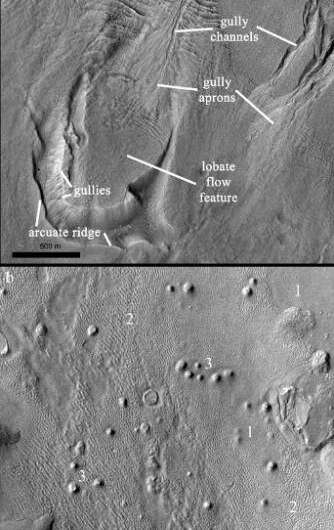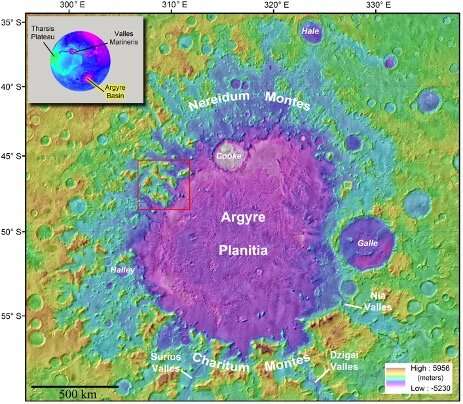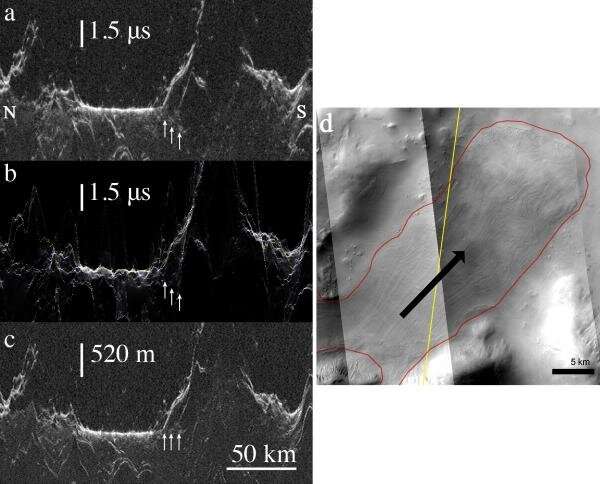Fig. a: HiRISE image ESP_039643_1400 of a lobate flow feature in Nereidum Montes. Fig. b: CTX image P04_002563_1388 of surface textures observed on mantling deposits in Nereidum Montes in various degradational states including smooth (1), dissected (2), and knobby (3). Credit: NASA/JPL-Caltech/MSSS. HiRISE images credit: NASA/JPL/UA
A large, previously unrecognized reservoir of water ice on Mars is well preserved and formed within the past few million years, says a paper led by Planetary Science Institute Senior Scientist Daniel C. Berman.
"Our radar analysis shows that at least one of these features is about 500 meters thick and nearly 100 percent ice, with a debris covering at most ten meters thick," said Berman, lead author of "Ice-rich landforms of the southern mid-latitudes of Mars: A case study in Nereidum Montes" published online in Icarus. PSI scientists Frank C. Chuang, Isaac B. Smith and David A. Crown are co-authors on the paper.
Global mapping of Viscous Flow Features (VFFs), a general grouping of ice-rich flow features in the southern hemisphere of Mars shows a dense concentration in Nereidum Montes, along the northern rim of Argyre basin. Located within a northwestern subregion of Nereidum Montes is a large number of well-preserved VFFs and ice-rich mantling deposits, the paper says, potentially the largest concentrations of any non-polar region in the southern hemisphere.
Processed data from the Shallow Radar (SHARAD) instrument aboard NASA's Mars Reconnaissance Orbiter spacecraft were used to search for basal reflections across VFFs within the region. For one in particular, these observations and analysis indicate that it is composed of nearly pure water ice. Model ages obtained from crater counts and their associated size-frequency distributions (SFDs) on both ice-rich mantling deposits and small lobate VFFs suggest that the deposits stabilized several to tens of millions of years ago in the Late Amazonian Epoch, and that small lobate VFFs likely formed due to the mobilization of mantling deposits.
Regional view of the Argyre basin on Mars. This study focuses on the mapping of VFFs within a sub-region of Nereidum Montes in northwestern Argyre (red box). Yellow box in northeastern Argyre shows the location of the feature analyzed with SHARAD data. Background image is colorized MOLA global gridded data (~463 m/pixel) draped over global THEMIS day IR basemap (100 m/pixel). Credit: NASA/JPL/ASU, MOLA image credit: NASA/JPL/GSFC
"Our results show that VFFs have more complete and diverse preservation states in Nereidum Montes than similar features in other regions on Mars. This region contains uniquely well-preserved mantling deposits associated with the VFFs. This key observation suggests that lobate VFFs are formed by the glacial flow of the mantling deposits on hillslopes," Berman said.
SHARAD observation of a VFF in Nereidum Montes. Fig. a: SHARAD data with a subsurface reflector (arrows), with north to the left and south to the right; Fig. b: synthetic simulation using HRSC DEM; there is no corresponding signal at the same time delay (see arrows for comparison); Fig. c: depth-corrected version using the velocity of light through ice. The corrected reflection appears flat and aligns with the plains beyond the VFF; thus, the material properties are consistent with water ice; Fig. d: CTX mosaic showing the VFF extending from massif in northeast Nereidum Montes. Yellow line shows SHARAD track and the mapped VFF extent is outlined in red. Flow direction indicated by black arrow. North is up. Credit: NASA/JPL-Caltech/MSSS
"This region would be an interesting landing site due to the large amounts of ice, which could be used as a source for water," Berman said. "Unfortunately, it is very mountainous terrain and it would likely be very difficult to land there."
Portions of this work were supported through a NASA Mars Data Analysis program grant NNX10AO21G awarded to PSI's David A. Crown.
More information: Daniel C. Berman et al. Ice-rich landforms of the southern mid-latitudes of Mars: A case study in Nereidum Montes, Icarus (2020). DOI: 10.1016/j.icarus.2020.114170
Journal information: Icarus
Provided by Planetary Science Institute

























